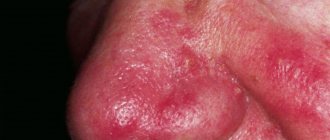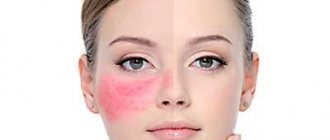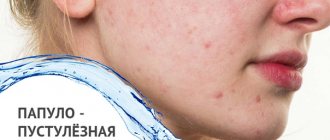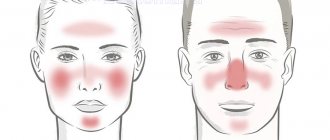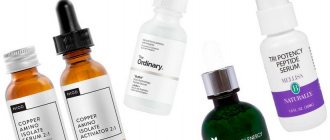Rosacea is a common non-infectious chronic skin disease with a number of typical symptoms:
- Redness of the skin and the appearance of spider veins in the cheeks, cheekbones, nose and forehead;
- Itching and burning in the affected areas;
- Large rosacea - papules and pustules in the affected areas.
Around the world, about 10% of men and women of all ages suffer from the disease. Most often, rosacea manifests itself at the age of 30–40 years and begins with the expansion of small blood vessels in the skin of the face (less commonly, the chest and abdomen).
Clinical guidelines for the treatment of rosacea
Rosacea is a chronic disease accompanied by inflammation of the skin. The capillary network stands out sharply, and purulent rashes appear. Blood rushes to the site of inflammation, the walls of blood vessels stretch, and excess fluid gradually accumulates in adjacent tissues.
There are four subtypes of the disease and one variant, granulomatous rosacea. Subtypes of rosacea are: erythematotelangiectatic (predominant), papulopustular, phymatous (hypertrophic), ocular (ophthalmic rosacea).
Etiology and pathogenesis
There is no single point of view about the origin and course of the disease, but according to the most common one, rosacea is a disorder associated with disorders of capillary innervation, primarily trigeminal nerve dysfunction. This is a mixed type cranial nerve - the largest of the twelve and is responsible for facial sensitivity, because. consists of very sensitive nerve fibers. Possible causes of the disease:
- exogenous climate forcing;
- poor nutrition;
- pathologies that have developed in the upper layer of the skin;
- microbe epidermal staphylococcus;
- mites of the genus Demodex (rosacea-like demodicosis);
- disruption of the gastrointestinal tract (for example, gastritis or ulcers);
- weak immunity;
- oxidative stress – cell damage;
- increased anxiety;
- insomnia;
- severe irritability;
- negative emotions;
- individuality of body constitution;
- exposure to proteins (cathelicidins, etc.) that protect the primary skin barrier from infectious pathogens that regulate blood pressure;
- hereditary factors;
- endocrine dysfunction, pregnancy, menopause (a relationship has been established between hemodynamic parameters in extracranial vessels and the content of individual hormones in the blood).
Dystonia and spasms play a negative role in the development of rosacea. Due to disruption of innervation, blood vessels become clogged. Externally, this is manifested by redness of the face and vascular networks on it. The facial vein supplies blood to the conjunctiva, the outer layer of the eyeball, which is why ophthalmic rosacea develops.
Modern dermatologists disagree about the etiology of rosacea. For example, the connection between the appearance of microorganisms on the surface of the skin and primary symptoms has not been clearly established. It has not yet been reliably established why the use of antibiotics always alleviates symptoms and improves the general health of the patient.
Clinical guidelines for the treatment of rosacea
Phymatous form (rhinophyma) –
Phymatous changes are called thickening of the skin (mainly in the nose area) - with the appearance of roughness, irregularities, and nodules on it. The thickening can be pronounced and then it leads to partial disfigurement of the face. Occurs more often in men, because they are less likely to seek medical help in the early stages of the disease. Thickening of the skin of the nose is called rhinophyma. Rarely, the phymatous form can be observed on the chin, forehead, cheeks, ears and eyelids.
Also, with this form, telangiectasia and hyperplasia of the sebaceous glands can occur. In the dermal layer of the skin, a dense inflammatory infiltrate is observed, in place of which then, for example, tissue proliferation and fibrosis occurs with the formation of nodes. There are several histological types of rhinophyma, for example, fibrous, glandular, fibroangiomatous, etc.
Treatment regimens for the phymatous form –
| Expressiveness | Treatment |
| Mild course - an increase in skin thickness, but without changes in contours |
|
| Moderate flow - there is a change in contours, but without a nodal component | In addition to the above:
|
| Severe flow - there is a change in contours with a nodal component |
Rhinophyma: removal of excess tissue with a CO2 laser
Clinical picture
The erythematotelangiectatic subtype of rosacea begins with a mild form that is easy to treat. It progresses slowly, intensified by a rush of blood to the skin of the face in stressful conditions, after physical exertion, at very high temperatures or frost. The next stage is persistent erythema of the cheeks and wings of the nose. Gradually, the rashes spread to the neck and upper chest, giving a pink tint. Because of the discoloration of the tissues, English dermatologist Thomas Bateman named the disease rosaceus, which is Latin for made of roses. Arterioles are the smallest blood vessels that can instantly change the width of the duct. As the disease worsens, the color of the affected areas becomes more and more saturated red. Due to the ongoing inflammatory process, the flow of fluid increases, which pathologically increases swelling. Patients complain of constant itching, a desire to scratch, and pick off inflamed plaques.
Rosacea clinical guidelines
The papulopustular subtype of rosacea is similar to the first. The main difference is a larger volume of pustular rashes covering the scalp and upper back. Swelling in men is more pronounced. The difference from other skin diseases is the absence of peeling and comedones - sebaceous plugs in the pores. Papules are unlike pustules because they are not filled with pus. This is a form of rash. The protrusions are soft or firm to the touch. They do not leave scars behind.
The phymatous or hypertrophic subtype involves significant thickening of the connective tissue, uneven distribution of pineal formations - fim. If the tissues of the nose become pathologically uneven, then the form is called rhinophyma, the forehead - metaphyma, the chin - gnathophyma, the ears (sometimes one-sided) - otophyma, the eyelids - blepharophyma. Types of tissue pathologies (fim): glandular, fibrous, fibroangiomatous, actinic. The skin looks like a reddish orange peel. The color does not fade. The appearance of conglobates - large spherical spots - also belongs to this subtype.
Ophthalmic rosacea has two distinctive features: simultaneous inflammation of the eyelids and membranes of the eye. Usually accompanied by the appearance of a red network of dilated vessels around the pupils. Patients complain of a scratching reflex, sensation of a foreign body under the eyelids. Sometimes the eyes are affected first, and then the surrounding skin. Complications may develop:
- Keratitis is an inflammation of the cornea of the eye, accompanied by clouding.
- Scleritis is an inflammatory reaction that develops in the outer layer of the eye.
- Iritis is inflammation of the iris.
Sometimes patients complain of unpleasant crusts in the corners of the eyes, peeling of the folds of the eyelids, and lacrimation. In severe cases, there may be a sharp deterioration in vision up to its complete loss - blindness.
Granulomatous rosacea is accompanied by the formation of dense, yellow, brown or red nodules, which may leave scars - post-acne. The rashes concentrate on the cheeks and areas around the body's natural orifices. For accurate diagnosis, histological examination is necessary.
Among the symptoms, clinicians distinguish between intermittent (non-constant) and persistent. The former appear only during periods of exacerbation, the latter do not disappear without treatment.
Clinical guidelines for the treatment of rosacea
Table. Characteristics of the severity of the disease
| Subtypes of Rosacea | Mild course | Moderate course | Severe course |
| Erythematotelangiectatic | Slight, initially unstable, later persistent redness Small, barely noticeable spider veins | Moderate persistent redness Noticeable spider veins | Severe frequent redness Multiple prominent spider veins |
| Papulopustular | Mild rash with small pustules | A few nodules and pustules | Large scatterings of pustules, can form plaques |
| Phymatous | Small spider veins Minor swelling Enlarged pores | Spider veins Nasal swelling | Pronounced spider veins Significant enlargement of the nose |
| Ocular | Minor itching Minor redness of the eyelids | Mild pain Inflammation of the eyelids Tumor on the eyelid Barley | Painful sensations Redness and inflammation of the eyelids Inflammation of the membranes of the eyes Redness of the corolla around the cornea of the eye |
Rosacea is difficult to distinguish from other dermatitis:
- Photosensitive after long-term use of hormonal drugs.
- Spring-summer pathological sensitivity to solar radiation.
- Discoid lupus erythematosus is a malfunction of the immune system.
- Tuberculous lupus, which triggers the process of tissue necrosis.
- Hormonal activity of tumors from cells of the APUD system (diffuse neuroendocrine system).
- Rendu-Osler-Weber disease is a hereditary disease.
- Granuloma with ring-shaped neoplasms.
- Acne is an acne disease.
- Dermatomyositis, which also penetrates muscle tissue.
The history of the course of the disease helps to distinguish rosacea from other pathologies. Stages of development: initial (episodic hot flashes), appearance of nodules or pustules, enlargement and thickening of the affected areas. The more complex the form, the more important it is to use a wide range of means of influencing the body during treatment. Don't forget about allergy medications and sedatives. Sometimes clinical recommendations for rosacea also include consultation with a psychologist, because Due to the unattractive appearance, the patient’s psycho-emotional state worsens and depression develops. If you do not contact a dermatologist, the disease risks causing the following complications:
- Development of abscesses.
- A secondary infection means that serious medical intervention will be required.
- Thickening of the skin that cannot be removed with conventional cosmetic products.
- Deterioration of vision.
- Psychological problems against the background of a changed appearance. In difficult cases it comes to depression.
Symptoms
Rosacea affects the skin of the face - cheeks, forehead, nose. Prolonged redness and spider veins appear, then small bright red nodules appear - papules, in the center of which purulent pimples appear. The rashes do not leave scars behind. A patient with rosacea feels itching and hot flashes to the face. The course of the disease is accompanied by frequent exacerbations and can last indefinitely. Over time, the skin of a patient with rosacea becomes rough and thick, and knobby formations appear. In some cases, lumpy hypertrophy of the skin of the nose develops - rhinophyma; deformation of the eyelids, ears, chin and forehead is also observed. There are no comedones with rosacea.
Diagnostics
The diagnosis, as recommended in medical textbooks and articles, is made based on the results of a physical examination of the visible manifestations of the disease and clarification of the medical history. The patient is asked in detail about the time of onset of primary symptoms. The doctor may ask about factors that, in the patient's opinion, reduce or increase symptoms. An additional research method, biopsy, is rarely used. This is the removal of a small piece of skin with a swab or scraping to identify parasites. In rare cases, monthly blood chemistry tests are performed for total bilirubin, serum alanine aminotransferase, aspartate aminotransferase, triglycerides, total cholesterol, glucose, serum creatinine, or alkaline phosphatase. Sometimes testing is done for antinuclear antibodies, which appear in the bloodstream as indicators of destruction of connective tissue cells. According to indications, seek advice from one of the specialists: an ophthalmologist, gastroenterologist, endocrinologist or psychotherapist.
An ophthalmologist is necessary if there is a risk of developing ocular rosacea. This specialist can prescribe supportive measures to alleviate the patient’s suffering: relieve the feeling of pain and dryness in the eyes, reduce sensitivity to bright light.
The gastroenterologist will prescribe additional diagnostic procedures to assess the condition of the digestive system. He can develop recommendations for proper nutrition or therapeutic fasting. It has been confirmed that smoked foods, saltiness, spices, citrus fruits, coffee-containing drinks, as well as alcohol increase the redness of the facial skin and provoke the appearance of new rashes.
An endocrinologist uses an examination to identify hormonal imbalances. Pathologies of the endocrine system often cause hot flashes. If unpleasant skin rashes appear, pre-prescribed hormonal therapy requires adjustment.
The psychotherapist will conduct a conversation to determine the general psycho-emotional state. He will advise what psychological techniques, relaxation techniques or sedatives can be used to get rid of depression. Patients suffering from rosacea, especially the severe form, often become more shy and withdrawn. Women usually hide imperfections with camouflage cosmetics, hide them behind long hair, and do not like to be seen. Females aged 30 to 40 years are at risk.
Treatment
Treatment goals:
- reducing the frequency and severity of relapses;
- reduction in the severity of symptoms;
- prevention of exacerbations;
- increase in remission periods.
Therapy is prescribed on the basis of the federal clinical recommendations “Rosacea”, developed by the Russian Society of Dermatovenerologists and Cosmetologists. These medical tips describe in detail all stages of treatment, the procedure for prescribing medications for external and oral administration. The last year of publication of this dermatological standard is 2020.
Dermatologists treat patients with rosacea. Provoking factors include meteorological factors - exposure to the sun, temperature changes, wind; nutritional - hot, carbonated and alcoholic drinks, spicy food; stressful effects; hormonal medications applied externally.
Federal guidelines state that using lightweight concealers has health benefits. You need to choose cosmetics carefully. Only a dermatologist can decide which substances will not aggravate the disease. Treatment usually includes:
- special soft medicinal cosmetic products, mainly creams;
- photoprotection;
- pharmacological preparations containing hormones that are applied externally;
- oral antibacterial drugs;
- agents that block histamine receptors;
- vitamins that regulate epithelial renewal and strengthen small blood vessels;
- physiotherapy: electrical destruction, incoherent intense light radiation (IPL), microcurrents, massage, cold treatment, laser;
- minor surgical operations to remove pus-filled lesions from the surface of the skin;
- folk herbal remedies that can only complement medical procedures, but not replace them.
Traditionally, drugs are prescribed with a high content of azelaic acid, which is isolated from the seeds of barley and wheat. Its use is justified by the fact that this substance is unable to penetrate deep into the skin. Azelaic acid relieves inflammation and brightens the epidermis.
Before any appointments, the doctor conducts a thorough diagnosis and takes into account contraindications for a particular patient. The regularity of the prescribed procedures is of great importance. External products are applied to previously cleansed areas of the face several times a day, only in the morning or at night (forehead, chin, nose, right and left cheeks). If the patient stops the procedures after the first signs of improvement, the disease will return again, because... refers to chronic.
Signs of the patient's recovery, as indicated in the Russian federal recommendations, appear gradually. Exacerbations occur less frequently; instead of pustules, only small reddish dots remain on the face. If the patient consults a dermatologist at the last stage, then annoying consequences in the form of scar formation are inevitable. It is better to consult a doctor immediately after the first alarming symptoms. For example, if half an hour after overheating or physical exertion the face remains red.
Papulopustular form -
The papulopustular form of rosacea manifests itself as persistent erythema in the middle third of the face, against which there are single or multiple papules or pustules (they look like pimples). Some patients may have plaques that rise above the surface of the skin. When treating this form at the first stage, the most important thing is to remove the inflammatory component, and only after that proceed to the correction of erythema or telangiectasia.
Treatment regimens for papulopustular form –
| Expressiveness | Treatment |
| Mild course - there are several papules or pustules without plaques; moderate persistent erythema is observed. |
|
| Moderate course - from several to numerous papules or pustules (but without plaques); moderate persistent erythema is observed. | |
| Severe – numerous papules or pustules with or without plaques; there is severe persistent erythema; Possible burning and tingling. | In addition to the above:
|
* The effectiveness of drugs with Ivermectin was confirmed in clinical studies “Stein Gold L, Kircik L, Fowler J, published in the journal Drugs Dermatol 2014; 13: 316-323."
Rosacea: treatment of papulopustular form (before and after photos)
Prevention
Along with treatment, preventative measures are also important. To prevent the development of rosacea, you need to avoid exposure to:
- sun and wind;
- unhealthy diet;
- harmful drinks;
- medicines;
- aggressive cosmetic procedures (peelings, surgical skin smoothing, rubbing, warming masks, etc.).
For prevention, specialists regularly prescribe short courses of antibiotics. It is recommended to constantly care for the skin with cosmetic products for gentle cleansing, moisturizing and protection from ultraviolet radiation (for sensitive skin). It is necessary to remember about the treatment of concomitant pathologies, especially diseases of the digestive tract. Getting rid of the consequences does not diminish the cause of the illness.



